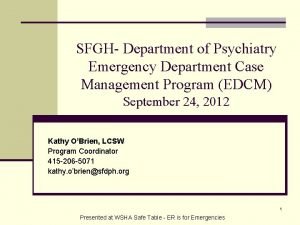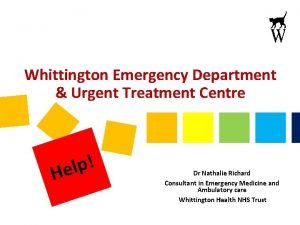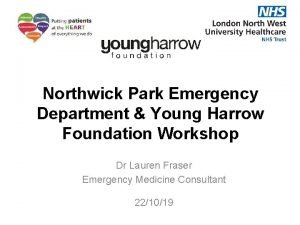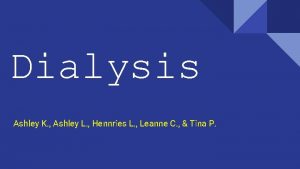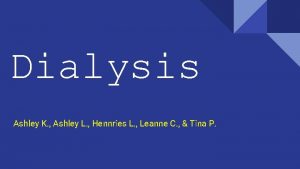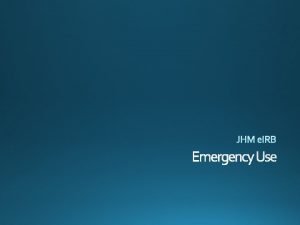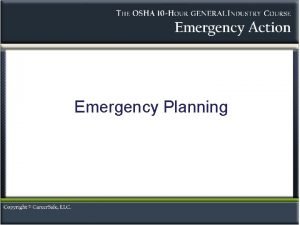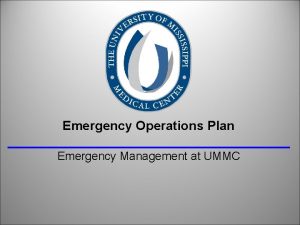EMERGENCY in the Emergency Department Ashley Killinder PAS




















- Slides: 20

EMERGENCY!!! in the Emergency Department Ashley Killinder, PA-S University of Kentucky, 2008

Objectives… l History of Emergency Department (ED) l Reasons for Overcrowding in the ED l Solutions to the Problem l Questions and Answers

History… l The first American hospital was established in 1752. l Patient Care = Free! l For-profit l hospitals in 1900’s Patient Care = Expensive!

History… l The introductions of Medicare, Medicaid, HMOs, and DRGs in 1970 s-80 s. l Patient Care = Free for some, expensive for others. l National Hospitals 2007 Administration Corruption l Abuse of the System l Collapse of Infrastructure l

Shocking Statistics… l 90% of Nation’s large hospitals operate Above Capacity l In the past 10 years, the number of patients seen in the ED has risen 26%, while population has grown only 11%. l In the past 5 years, the number of Medicaid patients seen in ED risen 23%.

How is the ED compensating? l They are not! l In the past decade, 500 EDs have been closed, 1/3 of those in rural populations. l There is currently a 114, 000 bed shortage in hospitals nationwide. l The US is currently in a state of Nursing Shortage as large numbers are leaving the medical field.

Why should we care? l The Emergency Department is the sole Safety Net healthcare provider in the US. l Since 1986, Federal Law requires the ED to treat all patients, regardless of the ability to pay. l Collapse in the ED Collapse of US healthcare system l Saturation of patient care outside the hospital.

The Bottom Line l The Emergency Department is in a state of Emergency!!! l Caused by: Decreased Bed Availability l Increased Numbers on Medicaid l Outflux of Hospital Staff l

Methods l The information presented today is based on data collected via Pub. Med. l The data is construed from 17 core articles, the majority of which were conducted research studies within the past five years.

Define Overcrowding… l How crowded is too crowded? National ED Overcrowding Study (NEDOCS) l Trzeciak and Rivers l l Quantitative l rather than Subjective Putting patient numbers makes more of a statement than personal judgment of overcrowding in the ED

Increased Numbers l Which population contributes the most to the overcrowding problem in the ED? l Uninsured patients ? l Medicaid patients ? l BOTH ? !

Increased Numbers: Ethnic, low-income, uninsured populations l Communities with higher levels of… Low-income l Racial/ethnic minorities l Immigrant residents l Uninsured population l l …were NOT the communities with the highest numbers of ED visits.

Increased Numbers: Influx of Medicaid/SCHIP l Populations with highest numbers of ED visits = highest number of Medicaid enrollees. l The average Medicaid patient has 16 more ED visits than the average uninsured patient.

Who is at Fault? l Are Medicaid patients the “Bad Guy”? l Look out for large cuts in Medicaid/ SCHIP funding

Outflux of Staff l Increased patient numbers = increased responsibility l 2004 NEDOCS questionnaire: 1. Qualify the degree of overcrowding l 2. If the staff felt rushed l 3. Quantify the degree of overcrowding l l Patient l : Staff ratio Overcrowding = Unsafe!!!

Solutions l Donated Care Program Local physicians provide pro bono work l Hospitals contribute $20, 000/year toward free community healthcare. l l Employeeing Mid-Level Providers Physicians Assistants are cost effective, skilled, and on the rise in the ED. l 47% of EDs use PAs in the ED l

Conclusion The ED is in trouble, reflecting a problem on the entire healthcare system. l Solutions to the problem must be initiated at every level of care. l Local communities provide hope for restoration. l Utilization of PAs eases burdens in ED. l Action must start NOW! l

References l l l l Barlett DL, Steel JB. Critical condition: how healthcare in America became big business and bad medicine. New York (NY): Doubleday; 2004. Brewer C, Kovner CT. Is there another nursing shortage? What the date tells us. Nursing Outlook. 2001 Jan; 49(1): 20 -26. Brewster LR, Felland LE. Emergency department diversions: hospital and community strategies alleviate the crisis. Issue Brief Cent Stud Health Syst Change. 2004 Mar; (78): 14. Congress of the United States. Diagnosis related groups (DRGs) and the medicare program: implications for medical technology – a technical memorandum. Office of Technological Assessment. 1983 Jul: 23 -25. Cowan RM, Trzeciak S. Clinical review: emergency department overcrowding and the potential impact on the critically ill. Crit Care. 2005 Jun; 9(3): 291 -5. Cunningham PJ. Medicaid/SCHIP cuts and hospital emergency department use. Health Aff (Millwood). 2006 Jan-Feb; 25(1): 237 -47. Cunningham PJ. What accounts for differences in the use of hospital emergency departments across U. S. communities? Health Aff (Millwood). 2006 Sep-Oct; 25(5): 32436. Dorsey JL. The health maintenance organization act of 1973 and prepaid group practice plans. Med Care. 1975 Jan; 13(1): 1 -9.

References l l l l Eastaugh SR. Overcrowding and fiscal pressures in emergency medicine. Hosp Top. 2002 Winter; 80(1): 7 -11. Ganapathy S, Zwemer F. Coping with a crowded ED: An expanded unique role for midlevel providers. Am J Emerg Med. 2003 Mar; 21(2): 125 -128. O’Malley AS, Gerland AM, Pham HH, Berenson RA. Rising pressure: hospital emergency departments as barometers of the health care system. Issue Brief Cent Stud Health Syst Change. 2005 Nov; (101): 1 -4. Oswanski MF, Sharma OP, Raj SS. Comparative review of use of physician assistant in a level I trauma center. Am Surg. 2004 Mar; 70(3): 272 -9. Taylor EF, Cunningham P, Mc. Kenzie K. Community approaches to providing care for the uninsured. Health Aff (Millwood). 2006 May-Jun; 25(3): 173 -82. Trzeciak S, Rivers EP. Emergency department overcrowding in the United States: an emerging threat to patient safety and public health. Emerg Med J. 2003 Sep; 20(5): 402 -5. U. S. Department of Health and Human Services. EMTALA: emergency medical treatment and labor act. Center for Medicare and Medicaid Services. 2006 Oct, Available on: http: //www. cms. hhs. gov/FACA/07_emtalatag. asp. Weiss SJ, Derlet R, Arndahl J, Ernst AA, et al. Estimating the degree of emergency department overcrowding in academic medical centers: results of the National ED Overcrowding Study (NEDOCS). Acad Emerg Med. 2004 Jan; 11(1): 38 -50.

Questions? …
 Buty prawdziwego szlachcica pan tadeusz
Buty prawdziwego szlachcica pan tadeusz Poème ne pleure pas devant ma tombe
Poème ne pleure pas devant ma tombe Lecture pas à pas
Lecture pas à pas Moteur pas à pas à aimant permanent
Moteur pas à pas à aimant permanent On ne peut pas ne pas communiquer
On ne peut pas ne pas communiquer Sfgh emergency department
Sfgh emergency department New nurses orientation
New nurses orientation Ambulatory care whittington
Ambulatory care whittington Northwick park emergency department
Northwick park emergency department Công thức tiính động năng
Công thức tiính động năng Thế nào là mạng điện lắp đặt kiểu nổi
Thế nào là mạng điện lắp đặt kiểu nổi Dot
Dot Bổ thể
Bổ thể Vẽ hình chiếu đứng bằng cạnh của vật thể
Vẽ hình chiếu đứng bằng cạnh của vật thể Phản ứng thế ankan
Phản ứng thế ankan Kể tên các môn thể thao
Kể tên các môn thể thao Sự nuôi và dạy con của hổ
Sự nuôi và dạy con của hổ Thiếu nhi thế giới liên hoan
Thiếu nhi thế giới liên hoan điện thế nghỉ
điện thế nghỉ Một số thể thơ truyền thống
Một số thể thơ truyền thống Biện pháp chống mỏi cơ
Biện pháp chống mỏi cơ





